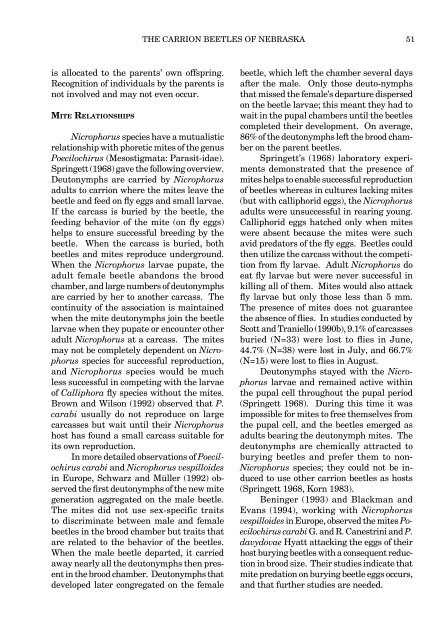Download full text - University of Nebraska State Museum
Download full text - University of Nebraska State Museum
Download full text - University of Nebraska State Museum
Create successful ePaper yourself
Turn your PDF publications into a flip-book with our unique Google optimized e-Paper software.
is allocated to the parents’ own <strong>of</strong>fspring.<br />
Recognition <strong>of</strong> individuals by the parents is<br />
not involved and may not even occur.<br />
Mi t e re l a t i o n s h i P s<br />
Nicrophorus species have a mutualistic<br />
relationship with phoretic mites <strong>of</strong> the genus<br />
Poecilochirus (Mesostigmata: Parasit-idae).<br />
Springett (1968) gave the following overview.<br />
Deutonymphs are carried by Nicrophorus<br />
adults to carrion where the mites leave the<br />
beetle and feed on fly eggs and small larvae.<br />
If the carcass is buried by the beetle, the<br />
feeding behavior <strong>of</strong> the mite (on fly eggs)<br />
helps to ensure successful breeding by the<br />
beetle. When the carcass is buried, both<br />
beetles and mites reproduce underground.<br />
When the Nicrophorus larvae pupate, the<br />
adult female beetle abandons the brood<br />
chamber, and large numbers <strong>of</strong> deutonymphs<br />
are carried by her to another carcass. The<br />
continuity <strong>of</strong> the association is maintained<br />
when the mite deutonymphs join the beetle<br />
larvae when they pupate or encounter other<br />
adult Nicrophorus at a carcass. The mites<br />
may not be completely dependent on Nicrophorus<br />
species for successful reproduction,<br />
and Nicrophorus species would be much<br />
less successful in competing with the larvae<br />
<strong>of</strong> Calliphora fly species without the mites.<br />
Brown and Wilson (1992) observed that P.<br />
carabi usually do not reproduce on large<br />
carcasses but wait until their Nicrophorus<br />
host has found a small carcass suitable for<br />
its own reproduction.<br />
In more detailed observations <strong>of</strong> Poecilochirus<br />
carabi and Nicrophorus vespilloides<br />
in Europe, Schwarz and Müller (1992) observed<br />
the first deutonymphs <strong>of</strong> the new mite<br />
generation aggregated on the male beetle.<br />
The mites did not use sex-specific traits<br />
to discriminate between male and female<br />
beetles in the brood chamber but traits that<br />
are related to the behavior <strong>of</strong> the beetles.<br />
When the male beetle departed, it carried<br />
away nearly all the deutonymphs then present<br />
in the brood chamber. Deutonymphs that<br />
developed later congregated on the female<br />
THE CARRION BEETLES OF NEBRASKA 51<br />
beetle, which left the chamber several days<br />
after the male. Only those deuto-nymphs<br />
that missed the female’s departure dispersed<br />
on the beetle larvae; this meant they had to<br />
wait in the pupal chambers until the beetles<br />
completed their development. On average,<br />
86% <strong>of</strong> the deutonymphs left the brood chamber<br />
on the parent beetles.<br />
Springett’s (1968) laboratory experiments<br />
demonstrated that the presence <strong>of</strong><br />
mites helps to enable successful reproduction<br />
<strong>of</strong> beetles whereas in cultures lacking mites<br />
(but with calliphorid eggs), the Nicrophorus<br />
adults were unsuccessful in rearing young.<br />
Calliphorid eggs hatched only when mites<br />
were absent because the mites were such<br />
avid predators <strong>of</strong> the fly eggs. Beetles could<br />
then utilize the carcass without the competition<br />
from fly larvae. Adult Nicrophorus do<br />
eat fly larvae but were never successful in<br />
killing all <strong>of</strong> them. Mites would also attack<br />
fly larvae but only those less than 5 mm.<br />
The presence <strong>of</strong> mites does not guarantee<br />
the absence <strong>of</strong> flies. In studies conducted by<br />
Scott and Traniello (1990b), 9.1% <strong>of</strong> carcasses<br />
buried (N=33) were lost to flies in June,<br />
44.7% (N=38) were lost in July, and 66.7%<br />
(N=15) were lost to flies in August.<br />
Deutonymphs stayed with the Nicrophorus<br />
larvae and remained active within<br />
the pupal cell throughout the pupal period<br />
(Springett 1968). During this time it was<br />
impossible for mites to free themselves from<br />
the pupal cell, and the beetles emerged as<br />
adults bearing the deutonymph mites. The<br />
deutonymphs are chemically attracted to<br />
burying beetles and prefer them to non-<br />
Nicrophorus species; they could not be induced<br />
to use other carrion beetles as hosts<br />
(Springett 1968, Korn 1983).<br />
Beninger (1993) and Blackman and<br />
Evans (1994), working with Nicrophorus<br />
vespilloides in Europe, observed the mites Poecilochirus<br />
carabi G. and R. Canestrini and P.<br />
davydovae Hyatt attacking the eggs <strong>of</strong> their<br />
host burying beetles with a consequent reduction<br />
in brood size. Their studies indicate that<br />
mite predation on burying beetle eggs occurs,<br />
and that further studies are needed.
















